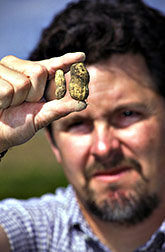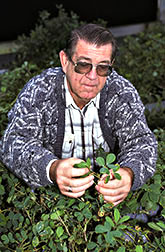Peanut Breeding Gets Hairy
|
|
Finding new peanut varieties with great flavor or improved pest resistance is good news. The bad news is that it’s a big problem to transfer these desirable characteristics into peanut varieties adapted to U.S. growing conditions.
For example, crossing the wild Latin American species, Arachis villosulicarpa, with domestic lines is usually doomed to failure.
The embryo-carrying plant rejects its progeny as a foreign invader, and no one knows why. Even if the embryo survives, the resulting plant is sterile.
Mexican gardeners have cultivated the peanut variety hirsuta--the socalled “hairy” peanut—for many years because of its taste. But peanut flavor is a complex symphony of sensory nuances. What makes the difference?
And some say the seeds have less oil than other varieties—and that the plant’s haired stem and leaves keep pests at bay. But could these useful traits be passed to domestic lines?
ARS chemist Harold E. Pattee is part of a team of peanut researchers trying to answer these questions. He works in ARS’ Market Quality and Handling Research Unit on the campus of North Carolina State University at Raleigh. His colleagues there specialize in peanut breeding—and overcoming odds.
Pattee heard about hirsuta varieties’ renowned flavor at a conference and decided to test the peanut with the university’s trained taste panel.
 Tom Isleib, a plant breeder with the North Carolina Agricultural Research Service, compares a Mexican hairy peanut (left) to the standard Virginia peanut. (K7562-2) |
“While there’s no pronounced flavor difference, it did seem hirsuta peanuts were sweeter than domestic varieties,” Pattee says. “That’s good news because we can use this characteristic to enhance the sugar content in domestic lines.”
But what about the claims of less oil? Former ARS researcher Dan Grimm and student Lilia Barrientos-Priego have been evaluating oil content. Grimm found oil contents as low as 39 percent in hirsuta seeds collected in Mexico. Barrientos-Priego found similar values when the varieties were grown in the United States. The domestic commercial variety called NC7 has 50 percent oil.
Flavor analysis is a major part of Pattee’s work, wherein he collaborates with university scientists on breeding efforts. Tom Isleib, a plant breeder with the North Carolina Agricultural Research Service, has been crossing hirsuta peanuts with varieties grown in Virginia and the Carolinas.
“Hirsutas may have pest resistance, sweetness, and low oil, but they also have purple seeds, late maturity, and rough pod type—all unacceptable to U.S. peanut processors,” says Isleib. “Because our quality controls are very stringent, we will need to breed out some of hirsuta’s negative qualities. But the benefits are worth the effort.”
Pattee also worked with state scientist Tom Stalker to cross wild varieties, such as A. villosulicarpa, with domestic ones. They developed a protocol in which the embryo and developing pod are removed from the parent plant in an early stage and grown in a medium acidic nutrient solution made of growth regulators and sugar.
The resulting hybrid is sterile, because the wild and domestic parents have a different number of chromosomal pairs. But researchers can overcome that by adding the plant extract colchicine to the growth medium to double the plant's chromosomes and restore fertility.
“We’ve been perfecting this process since 1984,” says Stalker. “Some of the plants we’re working with were collected by my predecessor in the late 1970’s.”
“Now that we have an effective protocol, it may open the door for other breeders to develop new hybrids for other legumes,” says Pattee. “It certainly points to enhanced disease resistance for southeastern peanut varieties.” — By Jill Lee, ARS.







